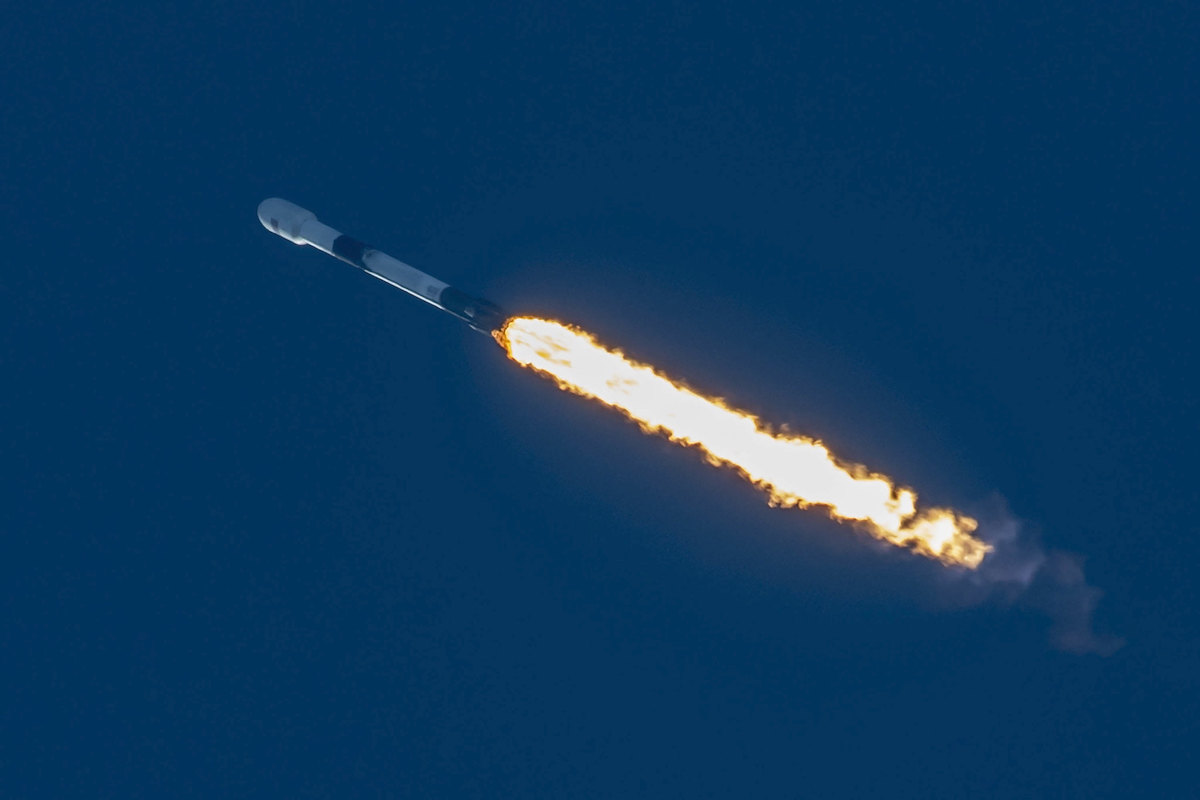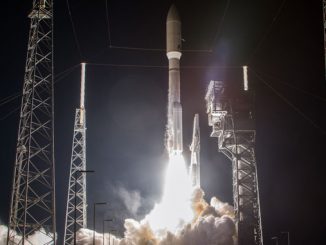
Leading all other nations, U.S. launch providers flew 44 missions in 2020 that aimed to place payloads in Earth orbit or deep space, with 40 successes. China followed with 35 successful orbital missions in 39 launch attempts.
Russia’s space program was in third place with 17 successful launches of Russian-built rockets in as many tries, including two Soyuz missions from the European-run spaceport in French Guiana. European-built launchers reached orbit four times in five attempts, and Japanese vehicles launched four times, all successfully.
India’s space program, grounded much of the year by the coronavirus pandemic, launched two successful orbital missions in as many attempts. Iran conducted two orbital launch attempts, with one success, and Israel launched a single mission to deliver a military spy satellite into orbit.
The most-flown type of space launchers in 2020 were SpaceX’s Falcon 9 and the Russian Soyuz. Chinese Long March rockets flew 34 times — more than Falcon 9s or Soyuz rockets — but come in a range of configurations, making them difficult to classify into a single family.
The final tally for orbital launches worldwide in 2020 ended up at 104 successful flights in 114 attempts. The ten launch failures were more than global launch providers suffered in a single year since 1971.
Despite the global pandemic, the 114 launch attempts last year tied 2018 for the most orbital launches globally since 1990, when Cold War-era military budgets helped propel more missions into orbit.
In 2019, there were 102 orbital launch attempts around the world, with 97 missions that successfully reached Earth orbit.
SpaceX led all launch companies in 2020 with 25 orbital missions that sent up hundreds of satellites for the company’s Starlink internet network, the first two flights with astronauts on SpaceX’s Crew Dragon spaceship, two space station resupply missions, and three launches that delivered national security payloads into orbit for the U.S. government.
All 25 orbital missions used Falcon 9 rockets, with 20 of the launches powered by reused Falcon 9 boosters, a capability solely demonstrated by SpaceX. One first stage in SpaceX’s fleet flew five times in 2020, the same number of missions performed by United Launch Alliance’s expendable Atlas 5 rockets or all European rockets last year.
ULA a 50-50 joint venture between Boeing and Lockheed Martin, accomplished six missions last year. Five flights with ULA’s Atlas 5 rocket carried national security payloads into orbit, launched the European-built Solar Orbiter science mission, and sent NASA’s Perseverance rover toward Mars.

A single Delta 4-Heavy launch in December deployed a top secret spy satellite for the National Reconnaissance Office.
Rocket Lab, builder of the light-class Electron rocket family, conducted seven missions last year, with one failure. The company is headquartered in Long Beach, California, and builds engines and other components in the United States, but assembles and launches its rockets in New Zealand.
Electron rockets are set to begin flying from a new launch pad in Virginia this year. Because of Rocket Lab’s U.S. headquarters, its launch statistics are counted under the column of U.S. companies.
Northrop Grumman conducted three launches from the Mid-Atlantic Regional Spaceport in Virginia last year, including two cargo launches to the International Space Station using Antares rockets, and a single flight of a solid-fueled Minotaur 4 rocket with satellites for the NRO.
Two newcomers to the U.S. small satellite launch business conducted their first orbital launch attempts in 2020.
Virgin Orbit, founded by billionaire entrepreneur Richard Branson, performed the first test flight of its airborne-launched LauncherOne rocket off the coast of Southern California in May. Astra, another startup smallsat launch company, launched two of its orbital-class rockets on test flights from Alaska.
The Virgin Orbit and Astra test flights all faltered before reaching orbit, but the companies say they gathered crucial data to set up for additional tries in 2021.
China’s 39 orbital launch attempts last year ties a record level of Chinese launch activity set in 2018, but China achieved more successful space launches that year.
The four Chinese launch failures this year included a mishap during the debut launch of the Long March 7A rocket in March, a Long March 3B failure in April with the Indonesian Palapa N1 communications satellite, and problems during launches of China’s light-class Kuaizhou 11 and Kuaizhou 1A rockets in July and September.
Major successes for China’s space program in 2020 included launches of the Tianwen 1 rover toward Mars in July, and the launch, landing, and return of the Chang’e 5 lunar sample collection mission in December.

Russian rockets delivered payloads into orbit 17 times in 2020, with the venerable Soyuz launcher conducting 15 of those flights. Russia’s heavier Proton and Angara launch vehicles each completed one mission last year.
In addition to launches with Russian military payloads, the Soyuz missions launched two crews to the International Space Station, two Progress logistics flights to the station, and three batches of more than 30 satellites for OneWeb’s commercial broadband network.
Soyuz rockets also launched on two missions with Emirati and French military reconnaissance satellites from the European-operated Guiana Space Center in French Guiana. Those flights were managed by Arianespace, the French launch services provider, but Russian engineers and technicians built and assembled the Soyuz boosters, and assisted in launch operations.
European rockets, also operated by Arianespace, launched from French Guiana five times in 2020. Three heavy-lift Ariane 5 rockets successfully took off from French Guiana with commercial communications satellites for Eutelsat, Intelsat, Sky Perfect JSAT, B-SAT, and the Indian Space Research Organization, a South Korean weather satellite, and a satellite servicing vehicle for Northrop Grumman’s subsidiary Space Logistics.
The smaller Italian-led Vega rocket program suffered one failure in two launch attempts last year.
Japan’s four orbital launch attempts last year — all successful — included three flights by the Mitsubishi Heavy Industries’ workhorse H-2A rocket. The H-2A missions carried two Japanese defense-related satellites to orbit, and deployed the Hope Mars orbiter for the United Arab Emirates.
The ninth and final launch of the more powerful dual-engine H-2B rocket in May lofted Japan’s last first-generation HTV cargo freighter with several tons of supplies for the International Space Station.
India performed two missions with its Polar Satellite Launch Vehicle in November and December, following a months-long grounding caused by restrictions stemming from the coronavirus pandemic. Both delivered their payloads to orbit.
Iran tried to launch two satellites in February and April, but only the second attempt was successful. And Israel’s Shavit launcher successfully placed the country’s Ofek 16 military surveillance satellite into orbit, the first Israeli satellite launch since 2016.

Florida’s Space Coast hosted more orbital launches than any other location last year, with 30 successful missions originating from launch facilities at Cape Canaveral Space Force Station and the Kennedy Space Center.
Before 2020, the previous record for launches from the Space Coast that reached orbit was 29, a mark set in 1966. There were 31 orbital launch attempts from Cape Canaveral that year, plus two suborbital test flights of the Apollo-era Saturn 1B launcher, for a total of 33 space launches from Florida in 1966, according to a launch log maintained by Jonathan McDowell, an astronomer at the Harvard-Smithsonian Center for Astrophysics who tracks global satellite and launch activity.
A run at breaking that record will have to wait for another year.
Space Launch Complex 40 at Cape Canaveral Space Force Station was the most-used launch pad worldwide in 2020, with 14 Falcon 9 missions taking off from there.
China’s launch sites at Jiuquan and Xichang each hosted 13 satellite launches in 2020. The Baikonur Cosmodrome in Kazakhstan, Russia’s Plesetsk Cosmodrome, Rocket Lab’s privately-operated launch site in New Zealand, and the Guiana Space Center in South America each had seven launches last year.
Here is the breakdown of orbital launch attempts from spaceports around the world, with numbers in parentheses representing failed missions:
- Cape Canaveral Space Force Station / Kennedy Space Center, Florida: 30 (0)
- Jiuquan, China: 13 (2)
- Xichang, China: 13 (1)
- Baikonur Cosmodrome, Kazakhstan: 7 (0)
- Guiana Space Center, French Guiana: 7 (1)
- Mahia Peninsula, New Zealand: 7 (1)
- Plesetsk Cosmodrome, Russia: 7 (0)
- Taiyuan, China: 7 (0)
- Wenchang, China: 5 (1)
- Tanegashima Space Center, Japan: 4 (0)
- Mid-Atlantic Regional Spaceport, Virginia: 3 (0)
- Pacific Spaceport Complex, Alaska: 2 (2)
- Satish Dhawan Space Center, India: 2 (0)
- De Bo 3 platform, Yellow Sea: 1 (0)
- Imam Khomeini Spaceport, Iran: 1 (1)
- Mojave Air and Space Port (staging point for 747 carrier jet): 1 (1)
- Palmachim Airbase, Israel: 1 (0)
- Shahroud, Iran: 1 (0)
- Vandenberg Air Force Base, California: 1 (0)
- Vostochny Cosmodrome, Russia: 1 (0)
Email the author.
Follow Stephen Clark on Twitter: @StephenClark1.



